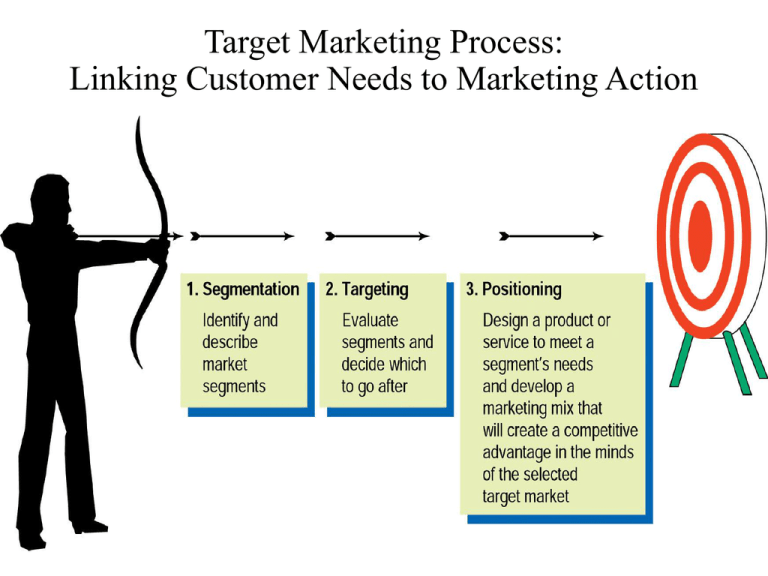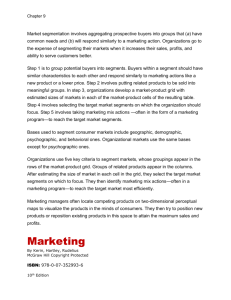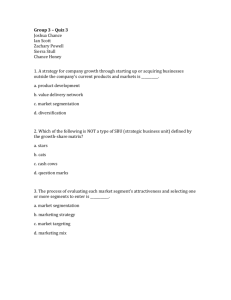Target Marketing Process: Linking Customer Needs to Marketing
advertisement

Target Marketing Process: Linking Customer Needs to Marketing Action Market segmentation links market needs to an organization’s marketing program Segmentation • process of dividing a larger market into smaller pieces based on one or more meaningful, shared characteristics and that will respond similarly to a marketing action • Segmentation variables are used to divide the market into smaller slices: demographics, psychographics, behavior, etc. Why Segment Markets? – One Product and Multiple Market Segments – Multiple Products and Multiple Market Segments – Segments of One: Mass Customization – The Segmentation Trade Off: CRM versus synergies Demographic Dimensions • • • • • • Age Gender Family structure Income and social class Race and ethnicity Geography Age • • • • • Children Teens Generation X, Y Baby Boomers Elderly Psychographics • Psychographic segments market in terms of shared attitudes, interests, and opinions • Segments include demographic information such as age and income, but also includes richer descriptions • Some organizations develop their own psychographic segments for their consumers, but others utilize national systems (VALS by SRI International) Segmenting by Behavior • Behavioral segmentation slices consumers on the basis of how they act toward, feel about, or use a product – Users versus nonusers – Heavy, moderate, light users – Usage occasions Segmenting Industrial Markets • Organizational demographics – – – – – firm size number of facilities domestic or multi-national type of business production technology utilized • NAICS characteristics Criteria for Forming Segments • • • • • Potential for increased profit and ROI Similarity of needs of potential buyers in a segment Difference of needs of buyers among segments Feasibility of a marketing action reaching segment Simplicity and cost of assigning buyers to markets Evaluating Market Segments • A viable target segment should satisfy these requirements: – Are members of the segment similar to each other but different from other segments? – Can marketers measure the segment? – Is the segment large enough to be profitable? – Can marketing communications reach the segment? – Can the marketer serve the segment’s needs? Targeting • Evaluating Market Segments • Developing Segment Profiles • Choosing a Targeting Strategy Targeting Strategies • • • • Undifferentiated Marketing Differentiated Marketing Concentrated Marketing Customized Marketing Undifferentiated Marketing • Appeals to a broad spectrum of people • Efficient due to economies of scale • Effective when most consumers have similar needs Differentiated Marketing • Develops one or more products for each of several customer groups with different product needs • Appropriate when consumers are choosing among well-known brands with distinctive images and it is possible to identify one or more segments with distinct needs for different types of products Concentrated Marketing • Entails focusing efforts on offering one or more products to a single segment • Useful for smaller firms that do not have the resources to serve all markets • Example: Hard Candy Customized Marketing • Segments are so precisely defined that products are offered to exactly meet the needs of each individual – Example: Levi’s Original Spin (custom) jeans, hair stylists • Mass customization is a related approach in which a company modifies a basic good to meet the needs of an individual – Example: Gateway computers, Proctor & Gamble’s products at Reflect.com Form Products to Be Sold into Groups Select Target Markets – Criteria to Use in Picking the Target Segments • • • • • Market size Expected growth Competitive position Cost of reaching the segment Compatibility with objectives and resources – Choose the Segments Targeting • Form Products to Be Sold into Groups • Develop a Market-Product Grid and Estimate Size of Markets Market-product grid showing how different Reebok shoes reach segments of customers with different needs Comparison of various kinds of users and nonusers for Wendy’s, Burger King, and McDonald’s restaurants Positioning • Developing a marketing strategy aimed at influencing how a particular market segment perceives a product in comparison to the competition • Strategy may also consider creating a “barrier to entry” for competitors Product Positioning • Head-to-head • Differentiation Developing a Positioning Statement • Analyze the competitors’ positions in the marketplace • Offer a product with a competitive advantage • Finalize the marketing mix • Evaluate the target market’s response so modifications to the positioning strategy can be made (repositioning) The Brand Personality • A Positioning Strategy attempts to create a brand personality for a product - a distinctive image that captures its character and benefits • How do marketers determine where their products actually stand in the minds of consumers? Perceptual Map Customer Relationship Management US companies spend about 75% of marketing $$ on existing customers • CRM strategy allows a company to identify its best customers, stay on top of their needs, and increase their satisfaction • CRM is about communicating with customers one on one • CRM views customers as partners Characteristics of CRM • Share of Customer • Lifetime Value of the Customer • A Greater Focus on High-Value Customers Steps in the CRM Process Identify customers Differentiate customers Interact with customers Customize for your customers








